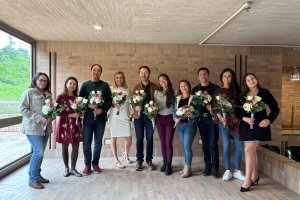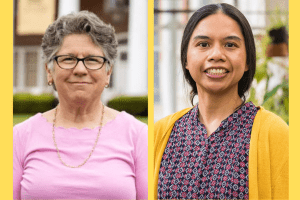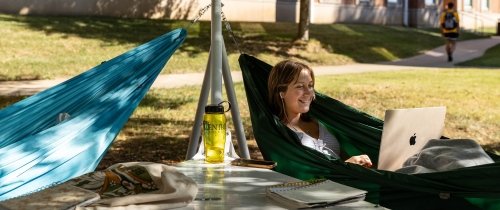
Centre’s focus on student well-being woven throughout campus life
Strategic integrations on the Centre campus elevate focus on well-being and increase access to wellness spaces, counseling and more tools for students to use.
Sometimes a moment is enough. Just ask the students and staff at Centre College.
Self-care and tending to personal well-being don’t always require an appointment or a check-in with a professional. Sometimes a moment listening to the leaves blow while swinging in a hammock helps the stress fade away. Maybe a 30-minute yoga session or mindfulness exercises to relieve that nagging anxious feeling. A quick workout with the perfect song in your headphones can help alleviate some frustrations.
But it can be challenging to carve out time and find a spot for even those small moments. Days get busy. Professors, peers, parents and coaches need attention; deadlines loom; social obligations arise. It can be easy to push those moments to the side.
Centre is making it easier to steal those wellness moments and help students keep their own well-being front of mind, no matter where they are on campus.
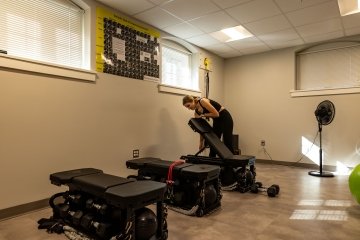
It’s an initiative to integrate well-being throughout the College at a time when students are more in touch with their own wellness, spending more time thinking about what they’re eating, what they’re drinking and how they’re feeling emotionally.
“We’re in a trend right now where students are grabbing for the idea of well-being,” said Ashley Hinton, director of health promotion, detailing how college students today are more focused on eating whole foods, tending their mental health needs or drinking less by socializing over alcohol-free mocktails.
The challenge for Centre staff is to leverage that student interest — and a national dialogue on student well-being — into a campus-wide initiative that leads to a population of healthier, happier and more successful students thriving both in and out of the classroom.
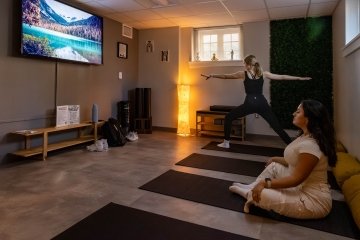
“It’s wonderful that our students are thinking about these issues,” said Ann Goodwin, associate dean for student well-being and director of counseling. “It’s a great generation because they care and they have higher expectations about well-being, gender roles and consent.”
Building on students’ interests and needs and providing crucial services, information and training is where Centre’s staff steps in. The College expanded counseling access in 2022 with counselor Hannah Harley joining the staff, brought Hinton on board and also welcomed Kelsey Preocanin as assistant director of health promotion.
New initiatives at the College include incorporating wellness spaces around campus and integrating counseling in strategic locations, such as the Office of Diversity, Equity and Inclusion. Newly remodeled residence halls are gaining well-being spaces through a recently renovated yoga and meditation space and functional fitness room, both with streaming guided instruction on demand. The restorative powers of exercise and nature have been incorporated into wellness classes focused on yoga and hiking in local areas. Well-being initiatives are also being integrated academically, complementing Wellness course offerings such as outdoor wellness and meditation.
“Our goal is to lace student well-being throughout the Centre experience,” said Vice President of Student Life Barbara LoMonaco. “Centre’s campus features spaces where students can have some unstructured outdoor relaxation, like in the hammocks that will be sprinkled around campus, a massage chair where they can listen to a relaxation app, a functional fitness room with size-inclusive equipment and thousands of videos on a touchscreen for a quick workout, or a break in the mindfulness and meditation room for stretching and yoga.
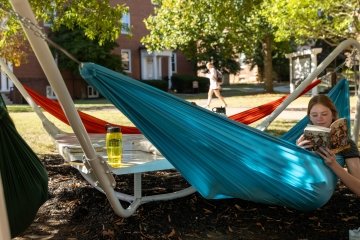
“These additions to our campus make wellness breaks accessible to students throughout the day. It doesn’t require advance planning to take advantage of and becomes an integrated component of our environment.”
The more traditional approach of helping students one-on-one remains, but a campus-wide commitment to well-being is better for the community, Hinton said, commending the “strategic and thoughtful” work of Goodwin and LoMonaco in laying the groundwork for early success.
“Centre has committed to well-being in ways that a lot of campuses talk about, but often don’t commit resources, instruction and funding,” Hinton said. “Thanks to data collection efforts, I didn’t come in wondering what the problem was, I came in with a full picture of the well-being needs on campus which allowed me to get straight to work.”
Campus integration of student well-being
Exciting developments across campus include wellness spaces incorporated into student housing, popup wellness spaces across campus and strategically integrating counseling services outside the student health center.
The goal is for a culture of well-being to become ingrained throughout campus via a number of intentional, strategic initiatives, as opposed to wellness being something “found” by visiting specified locations.
“We have a functional fitness space, a sensory room and a meditation/mindfulness room,” Hinton said. “And we’re working with outdoor spaces to find more ways to foster time in nature, wellbeing, fitness and play across the campus.”
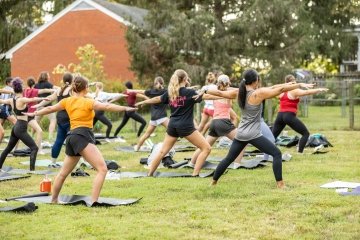
For instance, dedicated wellness can be found in the newly remodeled Stevenson Vinson Hall, easing access for students who might not be keen to work out in a heavily utilized gym space or join a large group for yoga.
The functional fitness spaces have inclusive benches to fit all body types, free weights and Total Body Resistance Exercise equipment, as well as on-demand guided fitness programs so each student can tailor their own workout experience.
The philosophy carries into the meditation/mindfulness room, which is designed to encourage students to unplug and unwind with furnishings chosen to ensure the spaces are not used as a study spot or socializing area. There are plants, yoga equipment, a TV for on-demand yoga and meditation sessions and little else.
“When I saw this design, it was the first time I saw a relaxation room and had a, ‘There’s only one reason I would walk into this room,’ kind of feeling,” Hinton said. “It literally forces you to unplug.”
The sensory room features textures, colors and more designed to create a therapeutic space to relax, re-focus and engage the senses. The space helps support neuro-diverse students but is available to anyone.
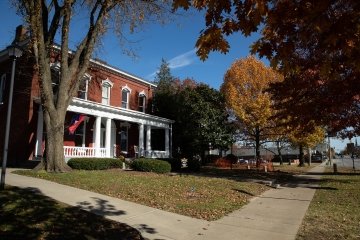
Similarly, the College experimented with embedding counselors across campus to make access easier and eliminate any perceived stigma associated with visiting the counseling office. Finding spaces that work for staff and students while maintaining confidentiality on a small campus were challenging, Goodwin said. Spaces in athletics and the library were explored, as was a partnership with the Office of Diversity and Inclusion.
“The space that made the most sense was ODI for a variety of reasons and one of the core values of our office has been trying to decrease barriers for students from various backgrounds and have it be inclusive,” Goodwin said. “The student feedback has been great. Now that we know the location works, we’re going to look at ways to make it more accessible and leverage this to have it increase access and decrease barriers for diverse students.
“It’s been a great partnership.”

